Unless you want to pay the electric hookup fee at a campground, a portable power station is the best way to stay powered while camping. Luckily, power stations have gotten a lot cheaper over the past few years and there are many more options. I’ve been lucky enough to test out several during camping trips with my family. Here are my picks for best camping power stations, as well as info as my 7-step guide to choosing a power station for camping (including how to calculate your power needs).
Quick Picks:
- Best Overall: Deeno X1500 – It’s the most affordable power station in its class while still having LiFePO4 battery, great features and a very long lifespan.
- Runner Up: EcoFlow River 2 Series – This series is my 2nd pick because the brand has a very good reputatoin. Their power stations charge very quickly and have long lifespans.
- Best Budget Power Station (Also Best Lightweight Power Station): Westinghouse 194 – This power station is cheap and lightweight because it uses older Li-ion battery technology. It’s great if you only have small power needs when camping.
- Best High-Capacity Power Station: EcoFlow Delta Max – Compared to other 2,048Wh power stations, the fans are also much quieter. It also has a higher wattage and surge power.
Camping Power Station Comparison Table
| Power Station | Capacity (Wh) | Watts/Surge | Battery | Cycles to 80% | # Outputs | Weight |
|---|---|---|---|---|---|---|
| Westinghouse 155 | 155 | 100/150 | Li-ion | 500 | 9 | 3.75lbs |
| Westinghouse 194 | 194 | 150/300 | Li-ion | 500 | 7 | 4lbs |
| Anker PowerHouse 521 | 256 | 200/450 | LiFePO4 | 3000 | 6 | 8.2lbs |
| EcoFlow River 2 | 256 | 300/600 | LiFePO4 | 3000 | 6 | 7.7lbs |
| Bluetti EB3A | 268 | 600/1200 | LiFePO4 | 2500 | 9 | 10.1lbs |
| Westinghouse 296 | 296 | 300/600 | Li-ion | 500 | 9 | 6.35lbs |
| Anker PowerHouse 535 | 512 | 500/750 | LiFePO4 | 3000 | 9 | 16.75lbs |
| EcoFlow River 2 Max | 512 | 500/1000 | LiFePO4 | 3000 | 11 | 13.4lbs |
| EcoFlow River 2 Pro | 768 | 800/1600 | LiFePO4 | 3000 | 11 | 17lbs |
| Anker PowerHouse 555 | 1024 | 1000/1500 | LiFePO4 | 3000 | 12 | 29.8lbs |
| EcoFlow Delta 2 | 1024 | 1800/2700 | LiFePO4 | 3000 | 15 | 27lbs |
| Deeno X1500 | 1036 | 1500/3000 | LiFePO4 | 3500 | 12 | 33lbs |
| Bluetti AC180 | 1152 | 1800/2700 | LiFePO4 | 3000 | 11 | 35.3lbs |
| Anker PowerHouse 757 | 1229 | 1500/2400 | LiFePO4 | 3000 | 13 | 43.9lbs |
| Anker PowerHouse 767 | 2048 | 2400/3600 | LiFePO4 | 3000 | 12 | 67.3lbs |
| Bluetti AC200Max | 2048 | 2200/4800 | LiFePO4 | 3500 | 16 | 61.9lbs |
| EcoFlow Delta 2 Max | 2048 | 2400/4800 | LiFePO4 | 3000 | 15 | 50.6lbs |
Best Power Stations for Camping
1. Deeno X1500
Choose because: Very affordable (especially for the amount of capacity you get), runs quietly, and has a very long lifespan
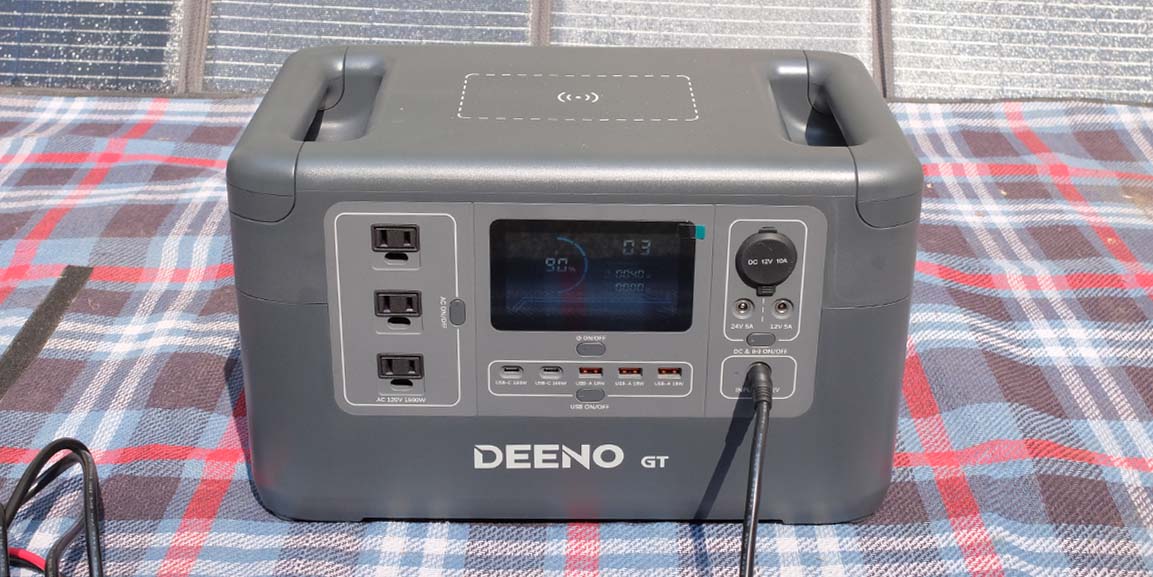
Quick Review:
The Deeno X1500 (1036Wh/1500W/3000W surge) is a fairly new power station on the market. Full disclosure that the brand sent me one for free to try out. Considering how cheap it is compared to other 1,000Wh capacity power stations, I was expecting something to be wrong with it. So, I was surprised at how well it works.
Deeno covered all the bases with the X1500 in terms of usability, LCD screen, charging methods and outputs. The reason I love this power station for camping though is because it is QUIET. The fans don’t constantly run and, even when they do kick on, aren’t loud like with other camping power stations. You can use the Deeno X1500 in a tent without it annoying you. It retains 80% capacity for 3,500 cycles — which is more than most other LiFePO4 power stations.
Right now Deeno only has the X1500 power station. But they are coming out with two other power stations this year.
Read my full review of the Deeno X1500 power station for camping here.
Pros:
- Runs quietly
- Very long lifespan
- Great value
- High surge power
Cons:
- Brand reputation not established
- No app yet
2. Ecoflow Power Stations
Choose because: Brand has a proven reputation, lots of capacity options, a long lifespan and the high-capacity models are expandable
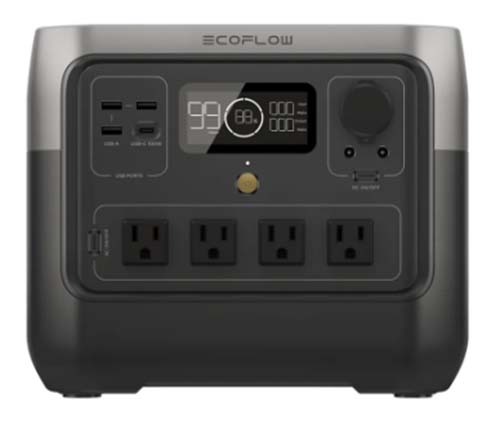
Quick Review:
EcoFlow is one of the best known brands when it comes to camping power stations. Their newer models of power stations use LiFePO4 battery technology and have cool features like Bluetooth connectivity and an app. When you compare the price per Wh, EcoFlow tends to win for cost.
Other than their reputation, the main reason to choose EcoFlow power stations is because they recharge quickly. They also support larger solar panels than similar-capacity power stations. The main downside of the EcoFlow power stations is that the fans get very loud, which can be annoying when camping.
There are tons of EcoFlow power stations to choose from. IMO, the ones below are best ones for camping because they use the newer LiFePO4 battery technology. The older EcoFlow power stations use Li-ion batteries!
EcoFlow Power Station Comparison Table
| Model | Capacity | Watts/Surge | Outputs | Weight |
|---|---|---|---|---|
| River 2 | 256 | 300/600 | 6 | 7.7lbs |
| River 2 Max | 512 | 500/1000 | 11 | 13.4lbs |
| River 2 Pro | 768 | 800/1600 | 11 | 17lbs |
| Delta 2 | 1024 | 1800/2700 | 15 | 27lbs |
| Delta 2 Max | 2048 | 2400/4800 | 15 | 42lbs |
Pros:
- Charges very quickly
- High surge power
- Nice mobile app
- Supports larger solar panels
- Large-capacity models are expandable
- Brand has a very good reputation
Cons:
- Loud fans
- Uncomfortable handle
- No wireless charging
Get EcoFlow Power Stations Here at Amazon or at REI
3. Westinghouse iGen Series Power Stations
Choose because: They are lightweight and budget-friendly power stations for low-power needs
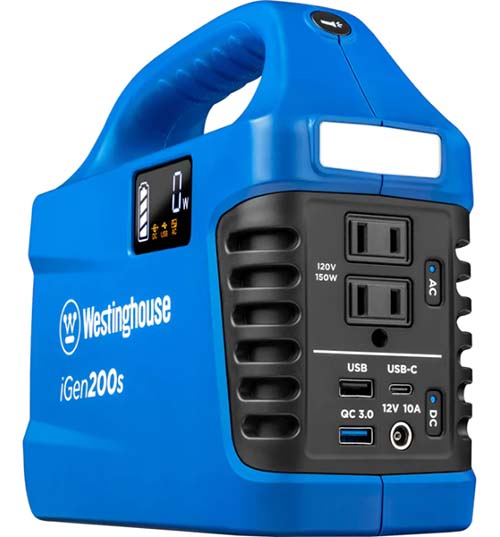
Quick Review:
If you want a cheap power station for camping, then Westinghouse is a good choice. They have several lower-capacity power stations which still have AC outlets.
Because Westinghouse power stations use Li-ion batteries, they are lightweight and affordable. I wouldn’t recommend getting one of their higher-capacity models though: if you need lots of capacity, then you are better off paying for a brand of power station which uses LiFePO4 battery technology.
Specs:
| Model | Watts/Surge | Outputs | Weight |
|---|---|---|---|
| 155Wh | 100/150 | 9 | 3.75lbs |
| 194Wh | 150/300 | 7 | 4lbs |
| 296Wh | 300/600 | 9 | 6.35lbs |
Pros:
- Very affordable
- Lightweight
- Quiet operation
Cons:
- Li-ion batteries
- Retains 80% capacity only to 500 cycles
4. Bluetti Power Stations
Best because: They have wireless charging and their AC200Max model has a lifespan of 3,500 cycles
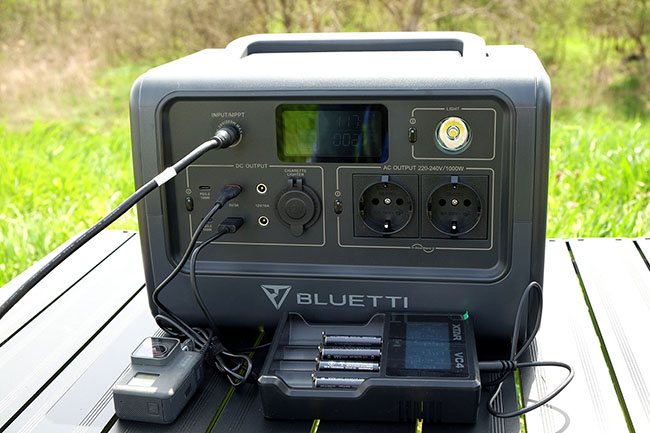
Quick Review:
Bluetti is another one of the most well-known brands for camping power stations. Their products are known to last a long time and use the latest technology when it comes to things like inverters.
Most Bluetti power stations are very well-designed and user-friendly. Note that I say most. I have the Bluetti EB70 (the brand sent it to me to try) and hate the LCD screen: it only shows charging in increments of 20%, which is ridiculous. The other models of Bluetti power stations have better LCD screens which show precise info, hence why the EB70 isn’t recommended here.
When it comes to cost, EcoFlow products are usually more affordable per watt-hour. Unless you can find Bluetti on sale, EcoFlow is probably the better choice. The exception is with the Bluetti AC200Max power station. Even though it’s probably going to be pricier than the EcoFlow power station of similar capacity, the Bluetti one has a lifespan of 3,500 cycles. If you use it frequently, then it’s a better long-term investment.
Bluetti Power Station Comparison Table
| Model | Capacity | Watts/Surge | Outputs | Weight |
|---|---|---|---|---|
| Bluetti EB3A | 268 | 600/1200 | 9 | 10.1lbs |
| Bluetti AC200Max | 2048 | 2200/4800 | 16 | 61.9lbs |
| Bluetti AC180 | 1152 | 1800/2700 | 11 | 35.3lbs |
Pros
- Brand has a good reputation
- Uses great technology
- Long lifespan
- Nice mobile app
- Large-capacity models are expandable
Cons
- Lots of complaints about bad customer service
- One of the pricier options
- Loud fans
Buy Here at Amazon
5. Anker Power Stations
Choose because: Fans are quieter than most other power stations and their large power station is on wheels
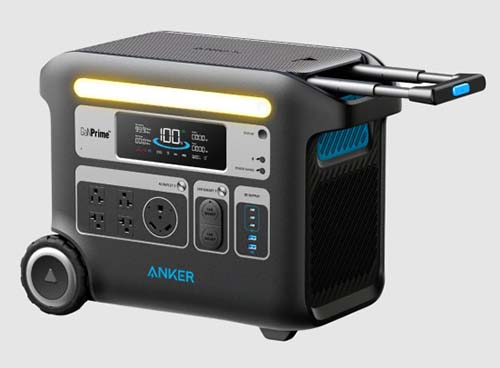
Quick Review:
I really love Anker power banks. They are lightweight and very reliable. Their power stations are also great – but not as good as Bluetti or EcoFlow IMO. Right now, Anker power stations are simply too expensive compared to similar models from these brands. They also don’t has as many outputs and are heavier.
The only reason I can see someone choosing Anker over EcoFlow is if you require lots of capacity and need it to be portable. The Anker AC200Max comes on wheels, so is very convenient to move around camp. However, for the price difference, you could just buy yourself a dolly to put the EcoFlow power station on.
Anker Power Station Comparison Table
Model Capacity (Wh) Watts/Surge # Outputs Weight
PowerHouse 521 256 200/450 6 8.2lbs
PowerHouse 535 512 500/750 9 16.75lbs
PowerHouse 555 1024 1000/1500 12 29.8lbs
PowerHouse 757 1229 1500/2400 13 43.9lbs
PowerHouse 767 2048 2400/3600 12 67.3lbs
Pros:
- Brand has a very good reputation
- Quieter than most other power stations
- Large-capacity model is on wheels and expandable
Cons:
- Expensive
- Handle sticks out on some models
Get Here at Amazon and Here at Anker.com
How to Choose a Power Station for Camping (In 7 Steps)
1. First Decide Whether You Really Need a Power Station
For me, a power station was a good investment because it allows me to work while camping (I can set up my laptop with a portable internet hotspot and work in the wilderness!).
If you don’t have high power demands though, you might be better off with a lightweight power bank. If your power demands are very high though, a power station might not be adequate and you’d be better off paying the electrical hookup fee at a campground.
For more, read: Is a Power Station Really Worth It for Camping?
2. What Size (Capacity) Power Station Do You Need for Camping?
Portable power stations come in various capacities, but the range is usually 150Wh to 2000Wh. Anything over 2000Wh is probably too large and heavy to be considered portable. And, IMO, power stations under 200Wh are a waste of money. If your power needs are that low, you are probably better off bringing a few power banks.
For more campers, a power station with a capacity of approximately 700Wh is going to be the best choice. This is enough power to keep small gadgets charged and run some appliances like a 12V cooler for a weekend trip.
Remember:
|
General Guidelines
- 200Wh power station: Good for weekend trips where you only need to recharge phones and cameras, run small LED lights and maybe play music from Bluetooth speakers for a few hours
- 500Wh power station: Good for longer camping trips where you only need to charge small devices. OR for weekend trips where you need to use fans or laptops.
- 1000Wh power station: This is enough capacity to recharge a laptop approximately 10 times. It will also keep a 12V cooler running for a weekend trip.
How to Calculate Power Needs for Camping
To figure out what size power station you need for camping, you’ll need to follow these steps:
1. Figure out how much power each device requires to run or recharge. First, find out how many watts your devices need to run. This number is often listed somewhere on the device. But if you only see a measurement for amps, you can multiply that number by the item’s voltage to convert into watts
2. Calculate how many hours you will use the device per day. Or how many times per day you will need to recharge it per day. Multiply this number by the amount of power it uses. If you need to recharge a phone once every two days (1/2 per day), then your total would be (Wh x 0.5).
3. Tally up the amounts for each device.
4. Divide the number from step 3 by 0.81. This is to account for energy inefficiency.
5. Multiple the number in #4 by how many days your camping trip will last.
6. Factor in how often you will be able to recharge your power station during your trip. Divide the number from step 5 by this.
For example, you calculate that you will need 1000Wh of power for a 6-day camping trip. But you will recharge the power station in your car on the third day. That means you only need a power station which is 500Wh.
How Long Can an Appliance Run on an Power Station?
To figure out how long a device will run on a power station, use this formula:
Capacity in Wh × 90% × 90% ÷ Wattage of appliance ≈ Run time
3. Do You Need to Power High-Wattage Appliances?
In addition to watt hours, power stations are also sized by watt output. This basically means how much energy the power station can deliver at the same time.
For example, if a power station has 1000 watt output, it could power (up to) 10 devices of 100 watts each. Or 5 devices of 200 watts each.
Common wattages of camping devices/appliances:
- LED light: 5 watts
- LED floodlight: 10 watts
- CPAP machine: 15-60 watts
- Small movie projector: 50-100 watts
- 12V cooler: 60 watts
- String lights: 90-125 watts
- 12V pump for air mattress: 105 watts
- Laptop: 120 watts
- Small car vacuum: 120 watts
- 12V fridge: 180-600 watts
- Kettle: 300 watts
- Coffee maker: 600 watts
Note: It’s unrealistic to run appliances like electric grills (1,700 watts), space heaters (1,500+ watts) and AC units (1,500+ watts) with a camping power station. They simply use too much energy. Even if the power station can handle the wattage requirements, the battery will drain very quickly.
4. Also Factor in Surge Power (aka Peak Power)
Some devices – especially those with motors – require a higher amount of energy just to get them started. For example, a 200-watt RV fridge might require 1000 watts just to get it going.
Because of this, many power stations have higher “surge power” or “peak power.” This is the amount of energy the power station can handle for a short period of time.
For example, the Deeno X1500 is capable of running 1500 watts continuously. But it can also deliver 3000 watts of surge power. By contrast, a power station with a low surge power won’t be able to deliver enough juice to get the fridge going.
If you want to use the power station with motorized appliances, then you’ll need a higher surge power.
5. Li-Ion or LiFePO4 Battery Technology?
Power stations for camping are made with either lithium ion (Li-ion) or (LiFePO4) battery technology. Li-ion batteries are cheaper and are lighter weight. However, LiFePO4 power stations last for many more cycles, so they are more affordable in the long run. Unless you are on a very tight budget, I only recommend choosing LiFePO4 power stations for camping.
*You’ll note that no Jackery power stations made my list because all models currently use the older Li-ion battery technology yet are still pricy.
Benefits of LiFePO4 Power Stations:
- Safety: LiFePO4 batteries are very stable so you don’t have to worry about them spontaneously bursting into flames like Li-ion batteries sometimes do.
- Withstand temperature extremes better: LiFePO4 batteries function well in temps of -4F to 140F whereas Li-ion batteries only function well from 32F to 113F. Bear in mind that power stations can get really hot (especially if you have to keep them in your car), so LiFePO4 power stations are much better for camping.
- Lower self-discharge rate: Lithium batteries will drain even if not used. However, LiFePO4 power stations have a very low self-discharge so will remain charged even when kept in storage for a long time.
- Longer lifespan: All lithium batteries lose some of their capacity over time. With Li-ion power stations, expect to lose 20% capacity after just 500 cycles. With LiFePO4 power stations, you can go through 2,500+ cycles before losing 20% capacity.
Benefits of Li-Ion Power Stations:
- Lighter: They are significantly lighter for the same amount of capacity, which is useful if you need to carry the power station around camp.
- Cheaper: The immediate cost of Li-ion power stations is cheaper. Though note that they don’t last as long, so end up being more expensive in the long run.
6. Comparing Price of Camping Power Stations
As a general rule, you should buy the highest-capacity power station that you can afford. The more capacity you have, the more use you will get out of the power station. And the more likely you will be able to use it for things other than camping, such as during power outages.
But camping power stations are still really expensive. Instead of just looking at the overall price, I suggest you calculate the price per watt hour. This will give you a better price comparison.
For example:
- 250Wh power station that costs $240 = $0.96 per watt hour
- 270Wh power that costs $300 = $1.11 per watt hour
- 770Wh power station that costs $600 = $0.78 per watt hour
- 1030Wh power station that costs $700 = $0.68 per watt hour
- 1300Wh power station that costs $1,100 = $0.85 per watt hour
In these examples, the 1030Wh power station is actually the best deal (assuming similar battery technology and features).
7. Decide Which Features Are Worth Paying For
Finally, decide whether there are any features you really want and how much extra you are willing to pay for them.
For example, you might want your camping power station to have these features:
- Longer lifespan
- Good LCD screen which gives precise information.
- Comfortable handle so I can carry it around camp easier.
- Simultaneous charge and discharge
- Multiple inputs and outputs
- USB Power delivery output
- Wireless charging
- Quiet fan


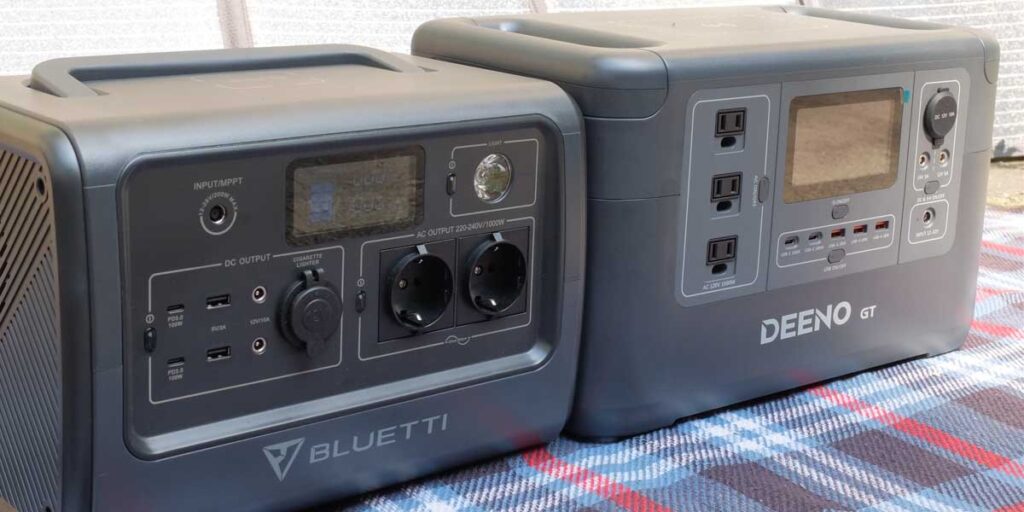

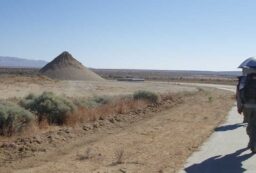








Post your comments